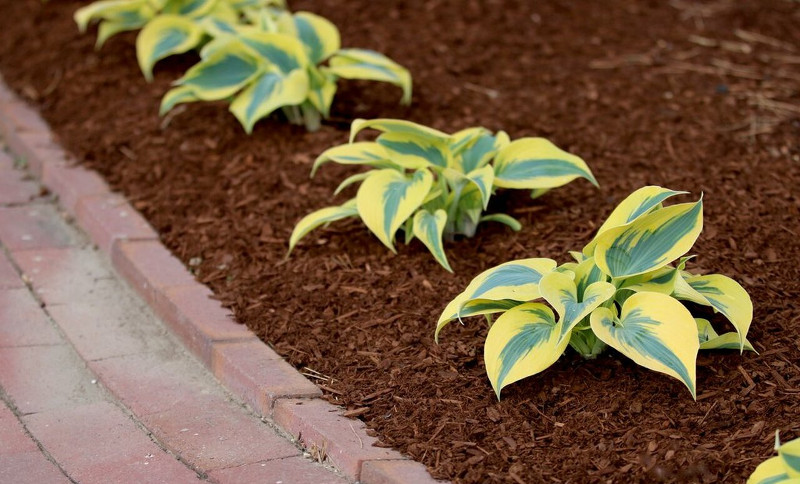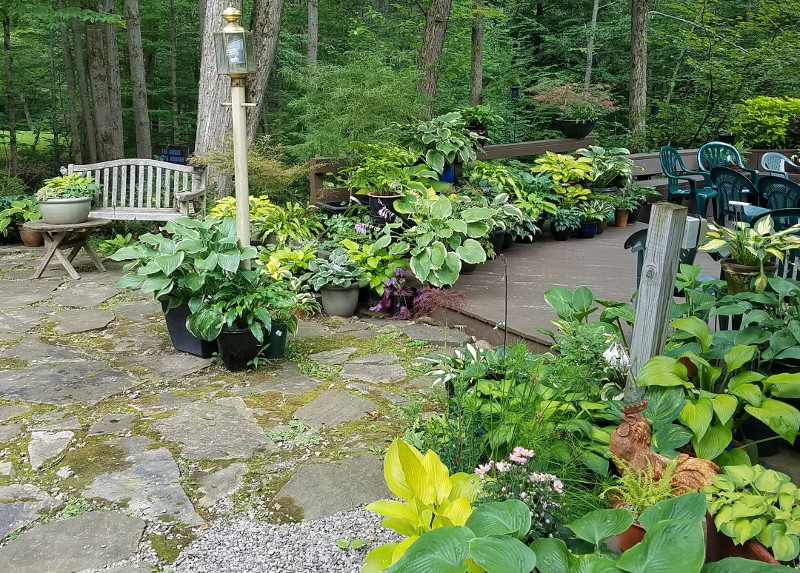Hostas are one of the most popular and common shade plants grown in gardens in the United States. The perennials are easy to care for and require little attention throughout the year. Grown mostly for its foliage and texture the plants add to the garden, hostas also bloom every year. The flowers are typically tall stalks that grow out of the mounded foliage with small delicate purple and white flowers at the end of each stalk.
Planting Hostas
Be sure to give the plant proper space between the plants. This ensure enough air circulation and helps prevent fungus from growing on the leaves. We recommend spacing between the plants equal to the mature width of the plant. So if the plant is 15 inches wide when fully grown, plant the hosta 15 inches apart, measuring from the center of each plant.
Pick a place that gets plenty of shade, as most hostas do not tolerate direct sunlight very well, especially in the afternoon heat. Mix in plenty of organic compost with the soil, as hosta prefer fertile soil. We also recommend adding mulch around the plants to help protect the root system and retain moisture.

Watering Hostas
Hostas love water. However, ensure the soil drains well because if the soil continuously remains wet the roots will rot. Newer plants will need watered at least every 3 days if not more. Established hosta need water at least once per week. Hostas growing in pots will need water even more frequently, because pots tend to dry out much quicker than the ground does.

Fertilizing Hostas
If the soil is nutrient rich and you add compost to the soil each year, that should be all the plants really need. If you would like to provide additional nutrients, you can apply fertilizer every 4 weeks until late summer. Do not fertilize after that.
Caring For Hosta in Pots
Hosta are easy to grow in containers and don't require too much additional maintenance if growing in a planter. The main considerations are how often the plants need watered, and winter care to ensure the plants survive harsh winters. The plants may also need fertilizer if you choose to use the same dirt year after year in the container.

Caring For Hostas in the Fall & Winter
Once the weather starts to turn cold, hosta leaves will begin to turn yellow, then brown and eventually die back to the ground. However, don't panic if this happens, as hostas are very cold hardy and shouldn't have any problems coming back the following year, given you aren't out of the growing zone range for the specific hosta you are growing.
Cutting Back Hostas
One thing gardeners can do each fall is cut back their hostas to about 1-2 inches above the ground. This helps the plants be healthier the following year and helps prevent slugs and snails from hiding out until the following spring. While this step isn't necessary to successfully grow hostas, we do recommend doing it if you have time. Do this after the first frost.
Hosta Winter Care
Once you have already cut back your hosta, there isn't much else to do until the spring. Give your hosta plants a drink before the first hard freeze. After that, the plants shouldn't need much else to care for them during the winter. If you are growing in pots, you can move the plants indoors to the garage to help protect the plants more.
Hosta Pests
One of the most common questions we get is whether or not hosta are deer resistant. We always answer with a resounding NO! Other animals also love to eat hostas including rabbits, squirrels, voles, rats, vine weevils. Snails and slugs are also very common pests that gardeners will have to deal with in certain areas of the country and at certain times throughout the year when food is scarce for the animals.
Preventing Slugs From Eating Hosta
Preventing Deer From Eating Hosta
Common Hosta Care Questions
How To Make Hostas Grow Bigger?
Good practice for growing bigger hostas is to be sure to give them plenty of room to grow when you're planting, give them a good balance of shade/sunlight (dappled shade or morning sun/afternoon shade.) Do not remove the foliage in the fall that you think is dead, some leaves may just be dormant and come back in the spring, which contributes to the size.
Why Do Hosta Leaves Turn Brown?
The most common causes of browned leaves on hostas are under-watering, too much hot, direct sunlight, or anything causing damage to the roots, ie root rot or fungal infection.
Why Do Hosta Leaves Turn Yellow?
Yellow leaves on a hosta can indicate that it's getting too much sun and getting scorched, or it could be a fungal disease causing petiole rot.
Are Hostas Better In Sun Or Shade?
Hostas are shade-loving plants, but not deep, full shade! They do need some sunlight, and most varieties will do great with morning sun and afternoon shade.
Do Hostas Spread?
Once they are well established, hostas will easily spread through rhizomes that sit just below the soil level. Every few years, you can split and divide them into smaller clumps if they're spreading into areas you don't want them.
Are Hostas Invasive?
Hostas are native to Asia, but even so, are not considered to invasive plants in the United States.
Are Hostas Annual Or Perennial?
Hostas are definitely perennials, coming back each spring.
How Big Do Hostas Get?
Hostas are available in a wide range of sizes. Some will stay as small as 6 inches tall, while others may reach up to 2 to 3 feet.
What Is The Growth Rate Of Hosta?
The growth rate of hostas varies greatly, from very slow to very fast, and depends on the variety and of course, soil quality, climate, care received, etc.
Are Hostas Drought Tolerant?
Hostas definitely prefer moist, well draining soil, but they can tolerate some drought.
Have a question about Hosta? Fill out the form below and we will try and get back to your question as soon as possible. We may even feature your question in this article to help other gardeners!
 |
Author Chris Link - Published 01-04-2021 |
